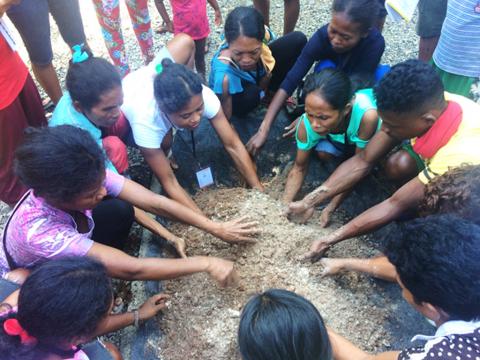TULONG-TULONG SA PAGSULONG. Mamanwa tribe helped in mixing thoroughly the compost before placing it inside the fruiting bag and later become the substrate for the mushroom. Photo by: JPDAJampac
SIBAHAY, LANUZA, Surigao del Sur – Before, they paid no attention to this spongy fungus they see in the wild; but now, they regard this as a new found gold. Thanks to the Training on Mushroom Production for Indigenous People (IP) sponsored by the Agricultural Training Institute-Regional Training Center XIII (ATI-Caraga), Mamanwans now have a source of good food and good money.
This training, which took place last May 7-9, 2019, came about after Sibahay’s chairwoman in the person of Maria Alili Silvano Butler requested Malacañang for any livelihood intervention for the IP community in her village. After discussions with Hon. Butler, Lanuza Mayor Salvacion Azarcon, staff from the Municipal Agriculturist Office of Lanuza and ATI-Caraga, it was agreed that such training shall be conducted.
The objective of the training was to increase the knowledge, practical skills and attitude of IPs on mushroom production in such a way that they will have additional food source and income. During the three-day activity, the participants were taught on kinds of mushrooms; propagation techniques, preparation of growing media, preparation of spawn, inoculation, planting, and harvesting. The third day was more interesting for the participants because they visited a mushroom farm in Brgy. Taguibo, Butuan City. The farm owner, Edilberto Bayot, inspired the group to venture into mushroom business and performed various mushroom recipes such as lumpia, ginataang kabote, polvoron and kropek.
Among the officials who were present during the training were: Hon. Anielyn Suñir, SB Member of Lanuza; Hon. Butler; and Marin Camacho, Municipal Agriculturist. During the first day of the training, Antonieta Cosmiano, Agricultural Technologist of Lanuza and resource speaker of the training, told the participants that mushroom has a lot of nutrients and health benefits. She said furthermore that it is a rich source of fiber, selenium, vitamins C and D. Increasing consumption of whole, unprocessed mushroom, also decreases the risk of obesity, diabetes, cancer, and heart disease.
On the second day, Cosmiano conducted an actual demonstration on how to prepare the fruiting bags using sawdust as a substrate. She showed the participants how to mix the materials and ingredients to make the compost, pack properly, sterilize and place the spawn inside the bag.
The third day was a tour at Bayot’s mushroom farm. Besides the tour and cooking session, there was also a review on fruiting bag preparation where each of the participants took turns in placing the compost inside the cellophane bags. Before the group left Butuan City, they also had a chance to tour around the demo farm of ATI-Caraga.
“Ang tribu Mamanwa sa Sitio Libas, Sibahay, Lanuza, Surigao del Sur mapasalamaton sa ATI tungod sa training nga gipahigayon. Kini nakahatag ug kahibalo, dugang pagkaon, palapad sa panginabuhian, ug kaayuhan sa among lawas (The Mamanwa tribe in Sitio Libas, Sibahay, Lanuza, Surigao del Sur is very thankful to ATI because of this training. It has given us knowledge, an additional source of food, livelihood and good benefits to our health),” said Datu Rosalino B. Montenegro, Indigenous People Mandated Representative (IPMR).
The Department of Agriculture-Regional Field Office 13 for its part gave away free mushroom fruiting bags to the participants plus bottles of mother spawn to ensure that the IPs will be able to apply what they have learned from the training and will have something to harvest after two weeks for personal consumption and business purposes.

